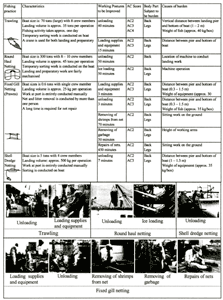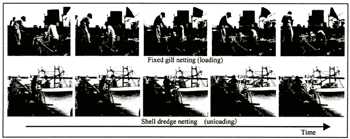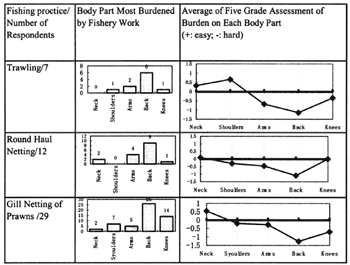|
STUDY RESULTS AND FURTHER ANALISIS
Evaluation of Physical Burden Caused by Fishery Work
Quantitative evaluation of physical burdens
Burdens of working postures are analyzed by using the OWAS, which are associated with each fishing practice on the landside of fishing ports such as unloading of fish catches, loadings of supplies and equipments, and repairs of nets. All of them seem to involve hard work because they accompany the lifting of heavy items and long working hours. Results of the analysis are shown in Table 4.
Table 4. Fishing practice and AC
| (Enlarge: 147KB) |
 |
AC2 ( shown as Table 2)
for every type of work is frequently observed among high AC scores that indicate the need for correction
of the working posture. AC3 and AC4, which require
the instant correction of the postures, are observed at the unloading of fish catches in trawling practice
(evaluation result are AC3 and AC4), fixed gill netting
(evaluation result is AC3), and shell dredge netting (evaluation result is AC3).
In short, these results indicate that uploading pasture is the most difficult posture in the landside
among evaluated postures except for round haul netting. It seems that evaluating the burden on each body
part can identify causes of such a high level of burden. The body parts on which heavy loads are concentrated
are the back and legs. The parts are equivalent to AC2 or higher action categories,
AC3 or AC4. Especially, the back in many types of
work is imposed with a burden. According to human engineering of a UNESCO report in 1999, the hazard factors
for backache are "heavy work (lifting, cargo handling, work demand physical strength, bending of the body
and twisting of the body, etc.) and long work hours under crouched postures". Fishermen also work under
these types of hazard factors. In case of the legs, the physical burden is particularly increased when
the center of gravity is placed on the bent knees. In the case of landing for round haul netting, the
impact of the vertical distance between the pier and the floor of the boat on the back and legs is not
particularly large because a machine is used for unloading large amount of fish catches. However, in case
of large-scale trawling, even though a machine is used for unloading like round haul netting, the horizontal
distance between the fishing boat and the pier and the vertical distance between the pier and the floor
of the fishing boat causes the bending or crouch of the back and legs because a fisherman manually hangs
the bucket on a rope in order to unloading the catches (Fig.3).
 Figure 3. Working postures of trawling (unloading)
Particularly, in case of the fixed gill netting of prawns and shell dredge netting, the vertical distance from 0.3 m to 1 m between the pier and the floor of the fishing boat, the horizontal distance between the pier and the fishing, and especially 35 kg of the fish catches per box influences the physical burden because all work is done by the manpower (Fig.4).
| (Enlarge: 38KB) |
 |
Figure 4. Working postures of fixed gill netting and shell dredge netting
Self-evaluation of physical burden by fishery workers
Questionnaire surveys on whole fishery work are conducted on fishery workers, and results of self-evaluation on the physical burden associated with different fishing methods are shown in Figure 5. In this Figure, the question of "the body part most burdened in fishery work" allows multiple answers while the question of "evaluation of the burden on each body part" is based on five-grade evaluation ranging from very hard (-2) to very easy (+2). The results show that a heavy burden on the back is commonly identified for all fishing practices. The indicated causes of the burden on the back in trawling are "bending work heavy muscle work such as transportation of the product by hand, and chilling of the body due to early morning work".
| (Enlarge: 63KB) |
 |
Figure 5. Self-evaluation of burden by fishery workers
Meanwhile, the types of heavy work indicated include "loading of the net and ice, replacement of the net, landing, sorting of fish and shellfish". In case of round haul netting, the indicated causes of the heavy burden are "net repair sitting on asphalt surface and unloading". In case of the fixed gill netting of prawns, the indicated causes of the heavy burden are "poor footing, bending work, and long sitting work" while "loading of the net and net repair" are considered particularly heavy work. These results confirm results of OWAS analysis except for factors such as chilling of the body due to early morning work and work on asphalt, which cannot be evaluated by the OWAS. In case of trawling and round haul netting, the back comes first and arms come second. The indicated cause is work on offshore like net lifting, unlike fishing practices, the results in fixed gill netting of prawns are similar to those of the results by OWAS. This similarity may originate from longer working hours on landside than those on offshore because the OWAS in this paper is done on the landside of fishing ports. Also, questions about the experiences of the injury and their causes are mainly related to work on the fishing boat such as falling during net lifting, being caught by the machine, fishing in rough weather, and striking rocks. Injuries on landside are the sprain by falling on a slippery surface and light wounds during the work to remove fish from the net and by fishhooks. The findings above suggest that work on landside of the fishing port involves a heavy burden on the back and legs such as bending and the transportation of heavy items although it is much less dangerous than offshore work.
PROBLEMS AND CAUSES IN WORK SPACE
Table 5 shows facilities, which should be improved soon. At those fishing ports where there are a number of workers, the evaluation on the volume of space is low. Danger and the difficult in mobility are high at ports with the large amount of fish catches because of the high level of vehicle traffic. Especially, the cars of pleasure boat users have an effect on the traffic too. Among facilities in need of improvement or new establishment, a rest room is the most urgent. The rest room is still in lack, and the current rest room is full with bad smell. Therefore, many women workers go home to use the rest room. The bad smell of the toilet results from the traditional toilets without flush. Resting places are mostly "homes". The reason for the frequent use of the home for toilet and resting purposes is a little way from fishing ports.
Table 5. Facilities in need of improvement in fishing ports
| Fishing Port |
Wada |
Chikura |
Katsuura |
Choshi |
Katakai |
| Narrow space |
・Piers
・Fishing gear repair yard |
None |
・Fishing gear repair yard |
・Anchorage
・Piers
・Sorting yard
・Fishing gear repair yard |
・Sorting yard
・Fishing gear repair yard |
| Danger |
None |
None |
・Piers
・Sorting yard
・Fishing gear repair yard |
・Piers
・Sorting yard |
・Piers ・Sorting yard
・Fishing gear repair yard |
| Difficulty in mobility |
None |
None |
・Sorting yard |
None |
・Piers
・Fishing gear repair yard |
|
CONCLUSIONS
In this paper, the characteristics of each fishing practice are discussed. Also, the working postures are analyzed by the OWAS and the action categories are presented to identify the postures, which should be improved soon. With the questionnaire and interviews, the facilities in fishing ports are evaluated. Each fishing practice shows the different action categories to improve the burden from different working characteristics and postures. The working postures with high action categories which should be improve are the preparatory work such as unloading and ice loading in trawling and round haul netting, unloading in shell dredge netting, and net repair and unloading in gill netting of prawns. The back is the most the part of bodies, which supports most burdens. The causes of the burden are the weight of the fish bucket, and the vertical and horizontal distance between the pier and the floor of the fishing boat. The facilities especially for the sanitation are necessary. The high level of the physical burden occurring at the moment of unloading of the fishing practices except for round haul netting results from the several causes such as the vertical distance between the pier and the floor of the fishing boat and the weight of fish catches.
REFFERENCES
Takaki, N. and K. Saeki. 2001. Researching and evaluation method of working environment at the fishing ports. Research report of National Fisheries Research Institute Fisheries Research Agency
Yamashita, S. 2000. Study on Improvement of Fishing Ports and Fishing Boat Functions Based on Analysis of Work Processes and Work Burden in Coastal Fishery. Research Institute for Construction Technology for Fishing Ports and Fishing Villages.
UNESCO Report. 1999. Human Engineering: Its Impacts. Japan Publication Service.
Louhevaard, V. and T. Suurnakki. 1992.OWAS: a method for the evaluation of postural load during work. Health Centre for Occupational Safety.
|